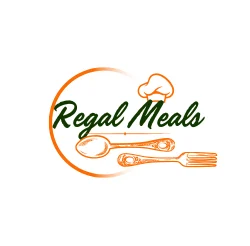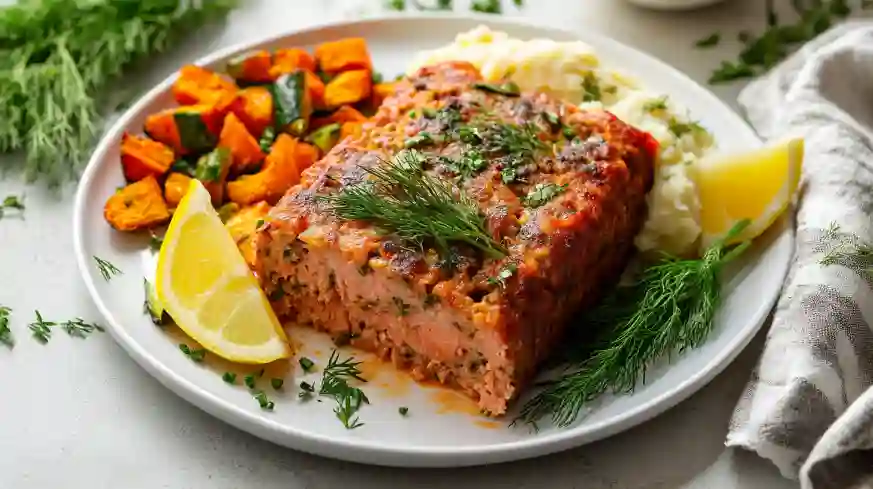discover Comfort with This Classic Salmon Meatloaf Recipe that takes you back to the warmth of your childhood kitchen. For me, that memory is wrapped in the aroma of my grandmother’s old fashioned salmon loaf, baking every Sunday afternoon. It was the kind of dish that made everyone gather around the table, no matter how busy the week had been. Moist, hearty, and full of flavor, it was a staple that never lost its charm.
Years later, I’ve reimagined that same beloved dish with a healthier, modern spin—welcome to my healthy salmon meatloaf. Whether you’re looking for a nutrient-packed meal prep option, a cozy family dinner, or something that caters to your low-carb lifestyle, this recipe checks all the boxes.
This oven baked salmon meatloaf is more than just delicious—it’s a smart, satisfying choice. Packed with protein and heart-healthy Omega-3 fatty acids, it’s low in saturated fat and can be easily adapted for keto, Mediterranean, or diabetic-friendly diets. With a few tweaks, it even transforms into a gluten-free salmon loaf for those with sensitivities. Versatile, wholesome, and comforting, this salmon meatloaf brings a classic favorite back to life—with benefits that fit today’s nutritional needs.
Easy Salmon Meatloaf Recipe Healthy, Moist & High-Protein
Course: DinnerCuisine: AmericanDifficulty: Easy4-6
servings10
minutes40
minutesApproximately 250–280 kcal per serving (depending on portion size and ingredients used)
kcalMoist, healthy, and protein-packed, this easy salmon meatloaf is perfect for a quick dinner or meal prep
Ingredients
2 cans (14-15 oz total) of wild-caught salmon, drained and flaked (or 1 lb cooked fresh salmon)
2 large eggs
1/2 cup rolled oats (use gluten-free oats if needed)
1/4 cup plain Greek yogurt (adds moisture and protein)
1 small onion, finely chopped
2 cloves garlic, minced
2 tablespoons fresh parsley, chopped (or 1 tsp dried)
1 tablespoon Dijon mustard
1 tablespoon lemon juice
1/2 teaspoon salt
1/4 teaspoon black pepper
Optional: 1/4 teaspoon smoked paprika or dried dill for added flavor
For Serving (Optional):
Fresh dill or parsley
Lemon wedges
Light dill yogurt sauce
Directions
- Preheat Oven:
Preheat your oven to 375°F (190°C). Lightly grease a loaf pan or line it with parchment paper. - Prepare the Mixture:
In a large mixing bowl, combine the flaked salmon, eggs, rolled oats, Greek yogurt, chopped onion, minced garlic, parsley, Dijon mustard, lemon juice, salt, pepper, and optional spices like smoked paprika or dill. - Mix Well:
Use a fork or your hands to mix the ingredients thoroughly until everything is well incorporated. The mixture should be moist but firm enough to hold its shape. - Shape and Transfer:
Press the mixture evenly into the prepared loaf pan, smoothing the top with a spoon or spatula. - Bake:
Place the pan in the preheated oven and bake for 35–40 minutes, or until the top is golden and the center is firm. - Rest and Slice:
Remove from the oven and let it rest for 10 minutes before slicing. This helps it hold together better. - Serve:
Serve warm, topped with fresh herbs and a drizzle of dill yogurt sauce if desired. Pairs well with roasted vegetables, mashed sweet potatoes, or a light salad.
Table of Contents
Fresh and Pantry-Friendly Ingredients for Salmon Loaf
One of the best parts about this salmon meatloaf recipe is its flexibility—you can whip it up with pantry staples or go gourmet with fresh ingredients. Whether you’re in the mood for a canned salmon meatloaf or a fresh salmon loaf, this recipe has you covered. It’s designed to work for various lifestyles and dietary preferences, while always delivering on taste and texture.
Base Ingredients for Canned or Fresh Salmon Loaf:
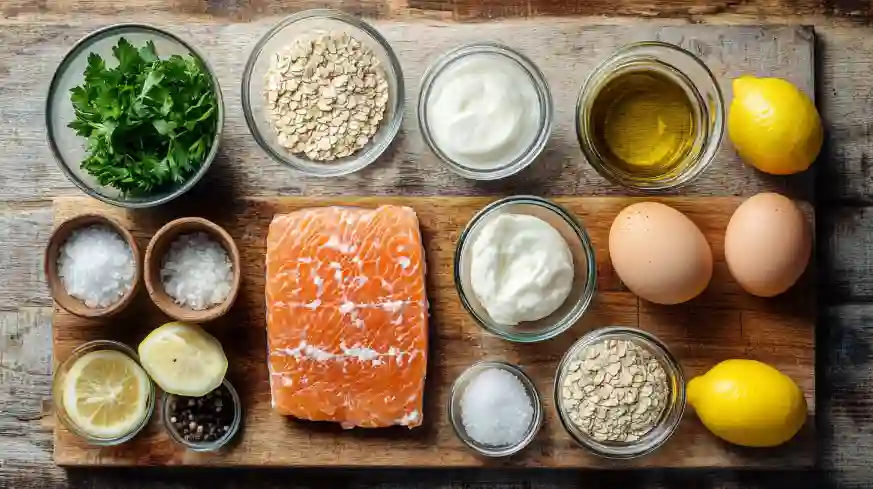
- 1 lb canned or fresh salmon (skinless, boneless preferred)
- 2 large eggs (or see eggless substitution below)
- ½ cup breadcrumbs (or oats/almond flour for gluten-free version)
- ¼ cup finely chopped onion
- 2 garlic cloves, minced
- ¼ cup mayonnaise (adds creaminess—use vegan mayo for dairy-free)
- 1 tbsp Dijon mustard
- 1 tbsp lemon juice
- Salt and pepper to taste
Optional Add-Ins for Flavor Variations:
- Fresh dill or parsley – for a herbaceous kick
- Grated cheese – cheddar or feta (omit for dairy-free)
- Chopped vegetables – like bell peppers, spinach, or zucchini
- Zest of one lemon – for brightness
- Crushed crackers – add crunch and texture
Substitution Tips for Special Diets:
- Gluten-free salmon loaf: Replace breadcrumbs with almond flour, certified gluten-free oats, or crushed gluten-free crackers.
- Eggless salmon meatloaf: Use 2 tbsp ground flaxseed or chia seeds mixed with 6 tbsp water (let sit for 5–10 mins).
- Dairy-free version: Use dairy-free mayo, skip the cheese, and choose plant-based toppings.
Salmon Selection Tips:
- For canned salmon, look for wild-caught, low-sodium varieties with minimal additives.
- If using fresh salmon, choose bright, firm fillets. Bake or pan-sear before flaking into the mix.
With these wholesome, adaptable ingredients, this easy salmon loaf recipe is both practical and packed with possibilities.
How to Make Salmon Meatloaf – Step-by-Step
Crafting the perfect salmon meatloaf is all about balance—moisture, flavor, and structure. Whether you’re using canned salmon for convenience or fresh fillets for that extra depth, this step-by-step guide ensures a delicious result every time. Here’s how to make a moist salmon loaf recipe that’s oven-baked to perfection, adaptable for multiple diets, and easy to pull off on any night of the week.

Step 1: Preheat and Prepare
Start by preheating your oven to 375°F (190°C). This ensures even cooking throughout.
Tip: Line a loaf pan with parchment paper or lightly grease it with olive oil to prevent sticking. This also helps with easy removal and cleanup.
Step 2: Mix the Base
In a large bowl, combine the following:
- 1 lb salmon (canned and drained or cooked and flaked fresh salmon)
- 2 large eggs
- ½ cup breadcrumbs (or gluten-free oats for oat-based version)
- ¼ cup chopped onion
- 2 cloves garlic, minced
- ¼ cup mayonnaise (or vegan alternative)
- 1 tbsp Dijon mustard
- 1 tbsp lemon juice
- Salt and pepper to taste
Mix gently with a fork or clean hands until all ingredients are just combined. Avoid over-mixing to maintain a tender texture.
Step 3: Customize with Add-Ins (Optional)
This is where you can add your personal touch:
- Chopped dill or parsley for fresh flavor
- Zucchini, bell pepper, or spinach for a salmon loaf with vegetables
- Grated cheese for extra richness (optional for keto or dairy-free diets)
- Zest of a lemon for a bright twist
For a low-carb salmon meatloaf, swap breadcrumbs for almond flour or ground pork rinds—a popular keto-friendly option that enhances flavor and texture.
Step 4: Shape and Transfer
Form the salmon mixture into a loaf shape. If not using a loaf pan, shape it free-form on a parchment-lined baking sheet.
Tip for Structure: A slightly sticky but firm mixture is ideal. If it’s too wet, add a touch more oats or almond flour. If it’s too dry, mix in a tablespoon of mayo or lemon juice.
Step 5: Bake to Perfection for Salmon Meatloaf
Place your meatloaf in the center rack and bake for 40–45 minutes. The internal salmon meatloaf temperature should reach 160°F (71°C) to ensure it’s fully cooked.
To check doneness:
- The top should be golden and slightly crisp.
- A toothpick or knife inserted in the center should come out clean.
- Juices should run clear, not opaque.
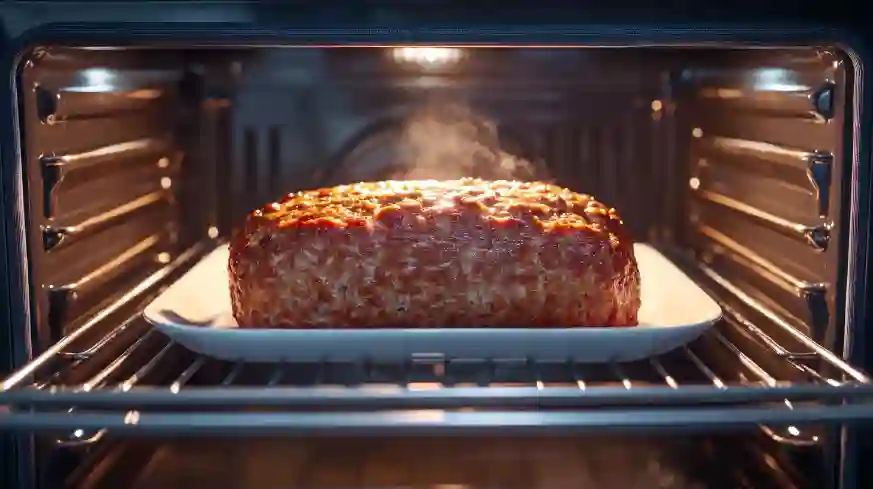
Step 6: Rest and Serve
Let the salmon loaf rest for 5–10 minutes before slicing. This helps retain moisture and prevents crumbling.
This easy salmon meatloaf recipe is foolproof, delicious, and adaptable. Whether you make it with oats, go breadcrumb-free, or tweak it for a keto salmon meatloaf, you’ll always end up with a healthy, hearty dish perfect for any occasion.
Tips, Variations & Customizations for Salmon Meatloaf
One of the greatest advantages of this salmon loaf recipe is its flexibility. Whether you’re following a specific dietary plan or just want to elevate the flavor and presentation, these tips and variations make it easy to customize your dish without compromising on taste or nutrition. Here’s how to tailor this healthy salmon meatloaf to fit your lifestyle—and make it even more delicious.
Diet-Friendly Swaps for Every Lifestyle
- Pescatarian Meatloaf Recipe: This dish is naturally pescatarian, relying solely on salmon for protein. Just ensure all added ingredients (like mayo or cheese) align with your preferences.
- Paleo Salmon Loaf: Skip dairy and grains by using almond flour or coconut flour instead of breadcrumbs and omitting cheese. Use avocado oil mayo or mashed avocado as a binder for a creamy texture.
- Clean Eating Salmon Recipe: Stick to whole, unprocessed ingredients. Choose wild-caught salmon, fresh herbs, cold-pressed olive oil, and fresh vegetables. Avoid canned goods with additives or preservatives.
Flavorful Additions for a Gourmet Twist
- Salmon Loaf with Dill Sauce: Serve with a light sauce made from Greek yogurt (or dairy-free alternative), fresh dill, lemon juice, and garlic for a bright, herby finish.
- Mediterranean Diet Salmon Loaf: Add chopped sun-dried tomatoes, capers, Kalamata olives, and a drizzle of extra virgin olive oil. These ingredients infuse the loaf with rich, briny, and savory flavors.
- Salmon Loaf with Vegetables: Boost both nutrition and texture by mixing in grated zucchini, carrots, or spinach. Just be sure to squeeze out excess moisture to maintain structure.
Topping Ideas for That Final Touch
- Lemon Glaze: Mix lemon juice with a touch of honey or maple syrup and brush over the top before baking for a subtle sweet-tart finish.
- Spicy Mustard Crust: Combine Dijon mustard with smoked paprika and brush on top of the loaf for a tangy, spicy kick.
- Cheesy Crust: Sprinkle shredded cheddar or parmesan on top during the last 10 minutes of baking for a golden, bubbling crust (omit for dairy-free diets).
Serving Suggestions to Complete the Meal
Pair your healthy salmon loaf with simple sides like:
- Roasted seasonal vegetables (think asparagus, carrots, or Brussels sprouts)
- Creamy mashed potatoes or sweet potatoes
- A fresh green salad with lemon vinaigrette for balance
With these ideas, your oven baked salmon meatloaf becomes not just a dish, but a versatile meal centerpiece that suits any table or dietary need.
Healthy Nutrition Facts for Salmon Meatloaf
When it comes to enjoying comfort food that’s as nourishing as it is delicious, this healthy salmon meatloaf stands out. With a clean ingredient list, high-quality protein, and heart-healthy fats, this recipe makes it easy to stay on track with your wellness goals—without sacrificing flavor or satisfaction.
Low-Calorie, High-Impact Nutrition
One serving of this low calorie salmon meatloaf (approximately 1/6th of a standard loaf) comes in at just under 250–300 calories, depending on your exact ingredients and customizations. It’s a smart option for those watching their calorie intake but still looking for a filling and flavorful main course.
Macronutrient Breakdown: Balanced & Satisfying
This high protein salmon loaf is built around nutrient-dense whole foods:
- Protein: Salmon and eggs contribute roughly 20–24g of protein per serving, making it a perfect post-workout or high-satiety meal.
- Healthy Fats: With 10–15g of fat, mostly from salmon, eggs, and olive oil or mayonnaise, this loaf offers a strong dose of omega-3 fatty acids—essential for brain function and cardiovascular health.
- Carbs: Depending on your binder, it contains just 5–10g of carbohydrates per slice. You can go even lower by using almond flour or making it breadcrumb-free, creating a keto salmon meatloaf alternative.
Health Benefits: More Than Just Flavor
- Heart-Healthy Salmon Loaf: Salmon is a top source of EPA and DHA omega-3s, which support cardiovascular health, reduce inflammation, and may lower triglycerides.
- Diabetic Friendly Salmon Loaf: With low net carbs and high protein, this loaf won’t spike blood sugar levels—ideal for those managing diabetes or insulin resistance.
- Supports Clean Eating: Use fresh herbs, vegetables, and minimally processed ingredients for a wholesome, clean version of this classic dish.
Nutritional Table (Per Serving)
(Based on a traditional 6-serving loaf with oats as binder and light mayo)
| Nutrient | Amount |
|---|---|
| Calories | 275 kcal |
| Protein | 22g |
| Total Fat | 14g |
| Saturated Fat | 2g |
| Carbohydrates | 8g |
| Fiber | 1.5g |
| Sugars | <1g |
| Omega-3s | 1000–1500mg |
| Sodium | 350mg |
This nutrient-rich salmon meatloaf fits beautifully into a wide variety of healthy eating plans—whether you’re aiming for heart health, managing blood sugar, or simply trying to eat more real, nourishing food.
Avoid These Mistakes When Making Salmon Loaf
Even a simple recipe like salmon loaf can turn out disappointing without the right technique. Whether you’re going for a classic salmon meatloaf or a modern low-carb version, knowing the most common pitfalls—and how to avoid them—can make all the difference between a dry, crumbly mess and a moist, flavorful success.
Problem: Salmon Loaf Is Dry or Crumbly
Fix: The key to a moist salmon loaf lies in using the right mix of binders and moisture-retaining ingredients. Make sure you’re including:
- Enough eggs to help hold everything together.
- Moisture-rich add-ins like mayonnaise, Greek yogurt, or grated vegetables (e.g., zucchini or carrots).
- Proper binding agents like oats, almond flour, or crushed crackers.
Avoid overmixing, which can squeeze out natural moisture and make the loaf tough.
Problem: Flavor Is Bland
Fix: Salmon has a mild flavor that benefits from bold additions. Use a combination of:
- Fresh herbs like dill, parsley, or chives.
- Spices such as garlic powder, paprika, or onion flakes.
- Zesty condiments like Dijon mustard or lemon juice.
- Consider a glaze or sauce, such as a dill yogurt drizzle or spicy mustard topping, to bring it all together.
Problem: Salmon Loaf Falls Apart After Baking
Fix: Structure is everything. Ensure you:
- Use adequate binding (eggs and dry ingredients in proper ratio).
- Let the loaf rest for 5–10 minutes after baking—this allows it to firm up and slice cleanly.
- Gently press the loaf mixture before baking to help it hold its shape.
Problem: Overbaked Salmon Meatloaf
Fix: Salmon can dry out quickly if overcooked. Always:
- Preheat your oven to 375°F (190°C).
- Bake for 40–45 minutes or until the internal temperature reaches 160°F (71°C).
- Avoid leaving it in the oven longer than needed—this is the most common cause of dryness.
Master these fixes, and you’ll enjoy perfect oven baked salmon meatloaf every time.
Salmon Meatloaf FAQs Answered
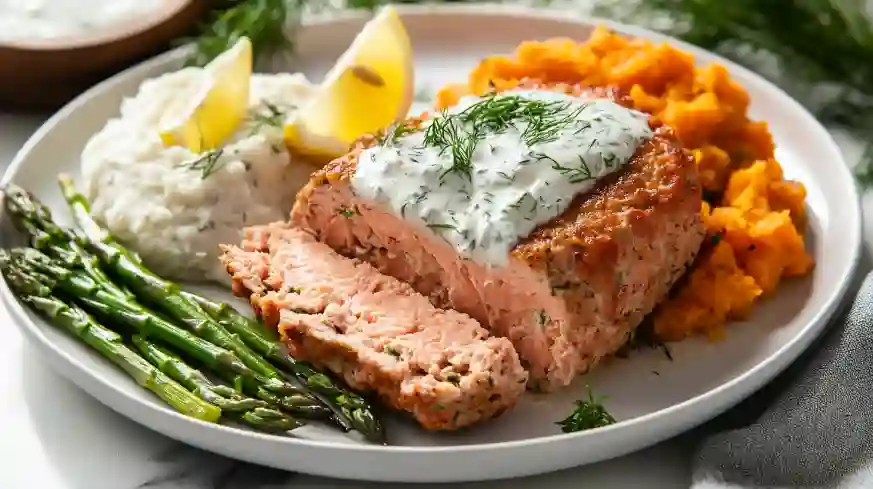
Whether you’re new to making salmon meatloaf or just want to improve your next batch, these frequently asked questions cover everything from storage tips to flavor pairings. Here’s what you need to know for a smooth, successful experience with this healthy, high-protein classic.
What Goes Well with Salmon Loaf?
Salmon loaf is incredibly versatile and pairs well with a variety of sides. Some delicious, well-balanced options include:
- Mashed sweet potatoes – their natural sweetness complements the savory loaf.
- Roasted asparagus or broccoli – adds crunch and color to your plate.
- Dill yogurt sauce – a cool, creamy topping that enhances the salmon flavor with herby brightness.
Can You Freeze Salmon Meatloaf?
Yes! This recipe is perfect for batch cooking and freezing.
- Let it cool completely, then wrap individual slices tightly in plastic wrap or store in an airtight container.
- Freeze for up to 3 months. To reheat, thaw in the fridge overnight and warm in the oven or microwave.
How Do You Make Salmon Loaf Moist?
Dry loaf is one of the most common issues. To keep it moist:
- Add mayo or Greek yogurt for creaminess.
- Use grated onion or zucchini for natural moisture.
- Don’t overbake—watch your time and temperature closely.
What’s the Best Binder for Salmon Loaf?
Binders help hold everything together. The top options include:
- Oats or crushed crackers for a traditional texture.
- Almond flour or flaxseed for a gluten-free or low-carb option.
- Always include eggs or a flax egg to complete the binding process.
Can I Make Salmon Loaf Ahead for Meal Prep?
Absolutely! This loaf stores beautifully.
- Cook, cool, and slice into portions.
- Store in the fridge for up to 4 days or freeze.
- Great for quick lunches or healthy dinners on busy nights.
With these tips, your salmon meatloaf will be ready to shine—anytime you need it.
Try This Best Salmon Meatloaf Today
If you’re craving a meal that’s easy, wholesome, and filled with nostalgic comfort, this salmon meatloaf recipe is your perfect match. Inspired by the classic old-fashioned salmon loaf but updated for today’s kitchens and diets, it’s a dish that blends tradition with nutrition. From its moist, flavorful texture to its clean ingredients, this is truly the best salmon loaf for any occasion.
Whether you’re preparing a weeknight dinner, planning meals for the week, or catering to keto, gluten-free, or diabetic-friendly diets, this recipe delivers every time. It’s simple enough for beginners and satisfying enough to become a family favorite. Plus, it’s endlessly adaptable—add fresh herbs, vegetables, or creative glazes to make it your own.
Now it’s your turn to bring this classic back to life in your kitchen.
Tried this simple salmon loaf recipe?
Leave a comment below with your favorite variation—did you go for the keto salmon loaf, add dill and lemon, or try it with veggies? We’d love to hear your take!
And don’t forget to check out more Best Smoked Salmon Brine Recipe: Easy Wet & Dry Brining Guide and The Incredible Benefits of Swordfish on our blog. With flavor and nutrition this good, you’ll want to come back for seconds.
